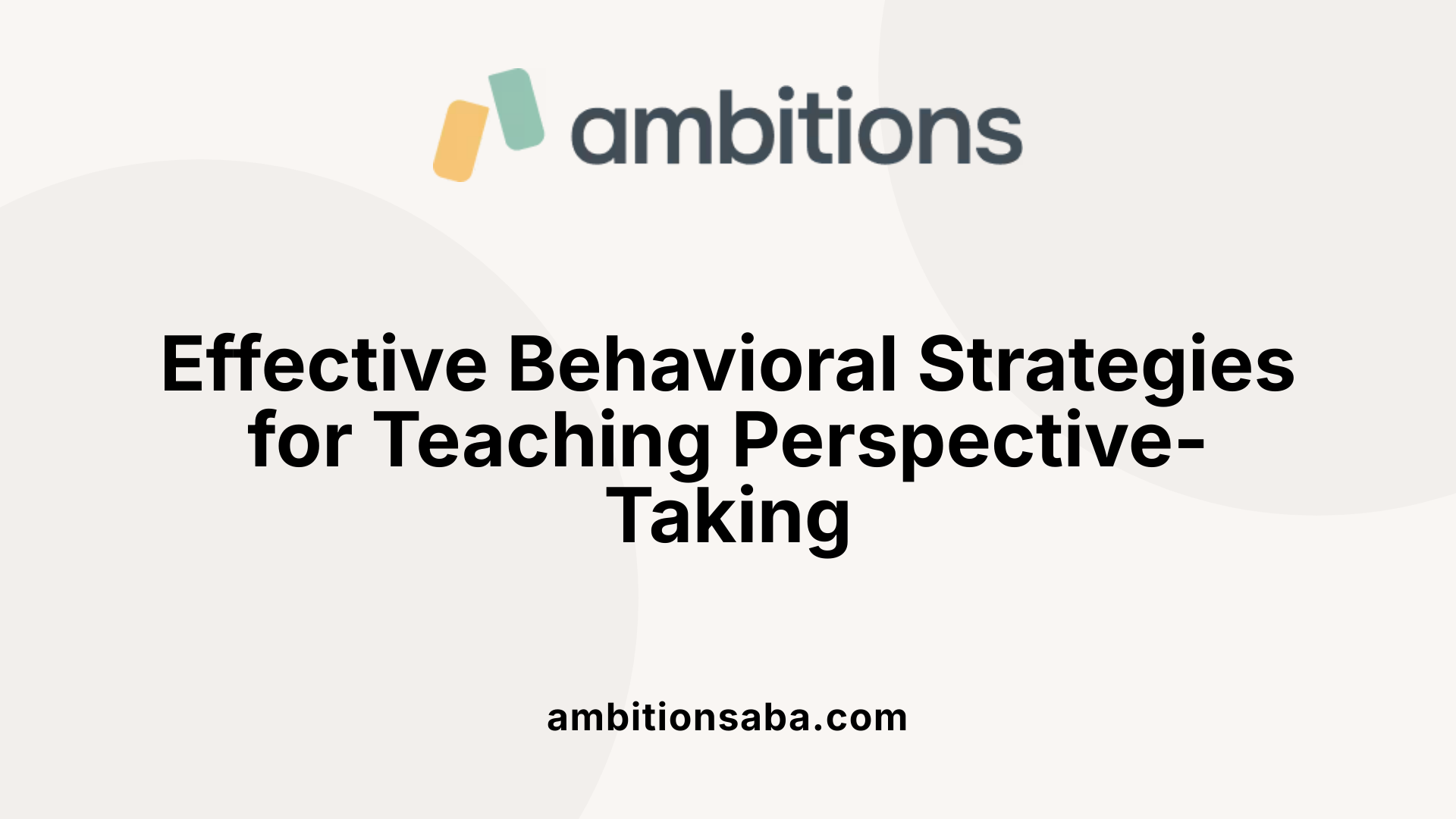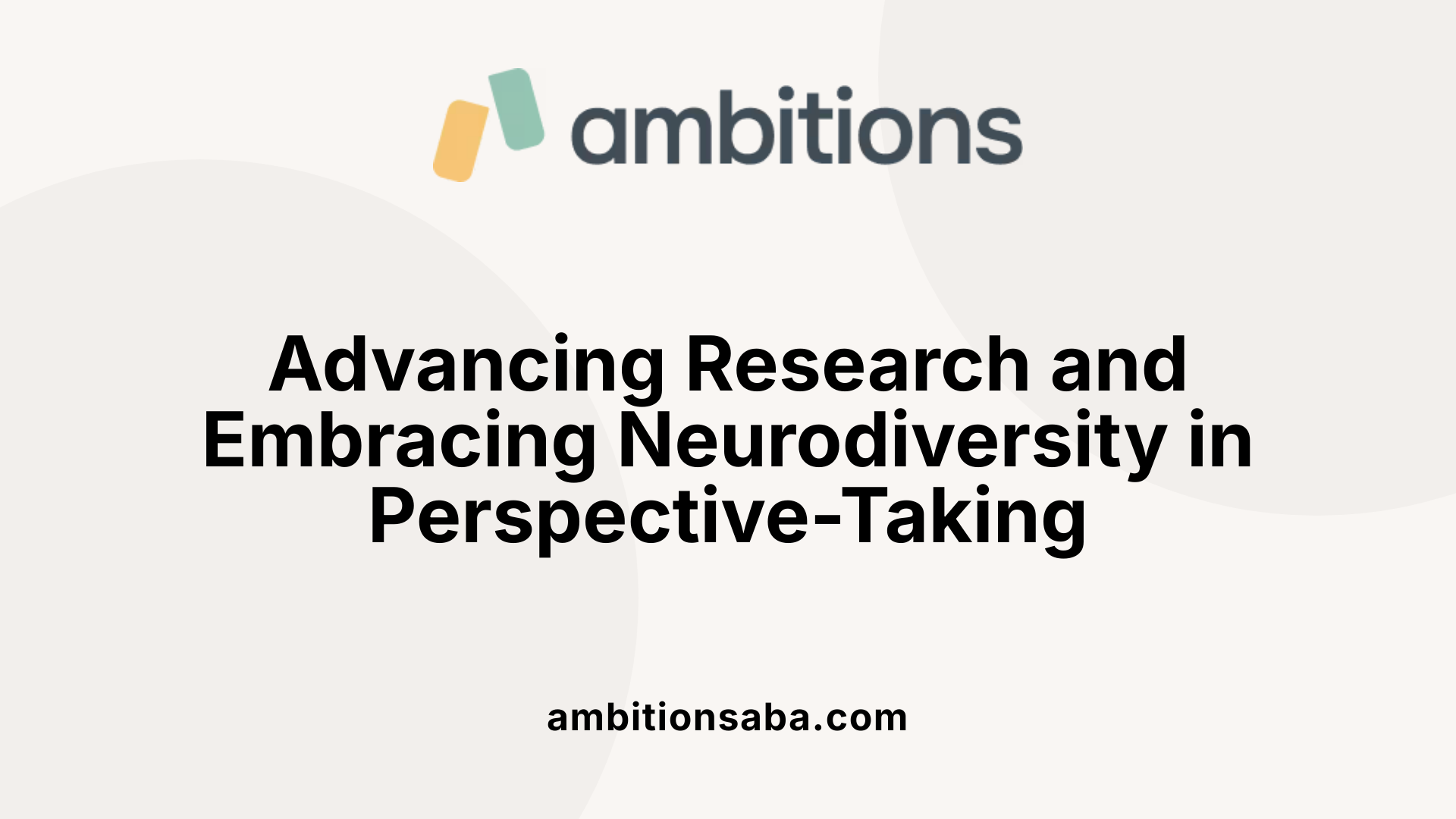The Importance of Perspective-Taking in Autism Therapy
Perspective-taking, the ability to understand and appreciate another person's viewpoint, is a vital social skill often challenging for children with autism spectrum disorder (ASD). Applied Behavior Analysis (ABA) therapy, a scientifically grounded approach, is extensively used to teach these essential social-cognitive skills. This article explores how behavioral interventions support the development of perspective-taking in autistic children, the methodologies employed, key ethical considerations, and future directions for research and practice.
Understanding ABA Therapy and Its Role in Teaching Perspective-Taking

What is Applied Behavior Analysis (ABA) therapy and how is it used to support individuals with autism?
Applied Behavior Analysis (ABA) therapy is a scientific approach that applies learning principles to encourage positive behaviors and skill acquisition in individuals with autism. This therapy uses well-structured, individualized interventions designed and overseen by professionals such as Board-Certified Behavior Analysts (BCBAs).
ABA focuses on key developmental domains including communication, social interaction, and daily living skills. It relies on data-driven techniques to identify behaviors to increase or decrease, ensuring progress is measurable and consistent. Caregivers are often part of the process to promote skill generalization beyond therapy sessions.
How does ABA address perspective-taking skills?
Perspective-taking—the ability to understand another person's thoughts and feelings—is vital for social understanding, especially for children with autism who commonly face challenges in this area. ABA therapy targets these social-cognitive skills through carefully designed interventions that teach children to recognize and interpret others’ emotions, intentions, and viewpoints.
By improving perspective-taking, ABA helps autistic individuals navigate social interactions more successfully without imposing neurotypical norms. The therapy aims to empower students to understand how others perceive and react, thereby promoting improved social communication and self-advocacy.
Common ABA Techniques for Teaching Perspective-Taking
Several behavioral strategies underpin ABA's approach to teaching perspective-taking:
Prompting: Guiding the learner through cues or reminders to demonstrate perspective-taking behavior.
Modeling: Demonstrating perspective-taking skills through role-playing or video examples, providing a clear template for learners.
Differential Reinforcement: Rewarding instances of accurate perspective-taking while reducing reinforcement for undesirable responses, which helps shape social understanding over time.
These techniques are often integrated into single-subject designs for individualized assessment and adjustment. This allows for targeted teaching tailored to each child's developmental level and needs.
Together, these strategies contribute to a comprehensive ABA approach that supports children with autism in developing meaningful social understanding through perspective-taking.
Behavioral Strategies and Theoretical Approaches to Perspective-Taking

What are the main behavioral intervention strategies for teaching perspective-taking?
Behavioral interventions for perspective-taking in children with autism commonly use strategies such as prompting, modeling, and differential reinforcement. Prompting involves giving cues or hints to encourage the child to consider others’ viewpoints. Modeling demonstrates appropriate social behavior for the child to imitate. Differential reinforcement reinforces correct perspective-taking responses while reducing undesired behaviors. These methods are part of Applied Behavior Analysis (ABA) approaches, aiming to enhance social-cognitive skills effectively.
How do the Non-Derived Response and Derived Response approaches conceptualize perspective-taking?
There are two theoretical approaches used in behavioral studies for perspective-taking. The Non-Derived Response approach treats perspective-taking as a direct learned behavior from specific teaching contexts. In contrast, the Derived Response approach views perspective-taking as a relational skill, where understanding others emerges from learned relationships between stimuli rather than direct teaching alone. Over time, research has shifted towards the Derived Response approach, recognizing the complexity of social cognition beyond rote response training.
Why are Single-Subject Designs predominantly used in this research?
Single-Subject Designs are widely employed because they allow individualized assessment of intervention effects on perspective-taking skills. Such designs are suited to the heterogeneity of autism and neurodivergence, letting researchers track progress on a participant-by-participant basis. This method supports tailored intervention strategies and helps clinicians identify which behavioral methods work best for each child, enhancing therapeutic precision.
Goals, Benefits, and Ethical Considerations of Teaching Perspective-Taking

What are the main goals and benefits of ABA therapy for autistic individuals?
ABA therapy aiming to teach perspective-taking in autistic children primarily focuses on enhancing social understanding and communication. Its goal is to increase helpful behaviors like communication skills, social participation, and independence, while reducing behaviors that hinder interaction. Improving perspective-taking skills allows autistic children to better understand others' thoughts and feelings, fostering more meaningful social relationships.
The benefits extend beyond just social skills. Children often experience improvements in language development, attention, and academic performance. These gains contribute to a higher overall quality of life and greater inclusion within their communities and schools. ABA achieves this through individualized, scientifically-supported interventions such as prompting, modeling, and differential reinforcement tailored to each child's needs.
What ethical concerns arise regarding compliance versus respect for neurodiversity?
A significant concern in ABA therapy is balancing teaching social skills without compromising the child's identity. Traditional approaches that emphasize rote phrases and behavioral compliance risk prioritizing conformity to neurotypical norms. Such strategies have been linked to negative outcomes like anxiety, depression, exhaustion, and lowered self-esteem.
Instead, many advocate for an approach that promotes understanding how and why neurotypical peers behave as they do, rather than forcing autistic children to "mask" or suppress their natural social presentation. Respecting neurodiversity means recognizing that differences in social behavior are not deficits but variations that deserve acceptance.
How can masking be avoided while promoting self-advocacy in autistic children?
Masking, or hiding autistic traits to fit in, often leads to emotional distress. Effective therapy should empower children to communicate on their own terms and encourage them to describe their own perceptions and emotions.
A focus on self-advocacy allows autistic children to understand others' perspectives while also expressing their individuality confidently. Therapy goals should shift from enforcing compliance toward helping students navigate social interactions with respect for their neurodivergent identities.
Why is peer education and acceptance important alongside individual interventions?
Educating peers to accept variations in social presentation plays a crucial role in creating inclusive environments. Instead of changing autistic individuals to appear more neurotypical, peers can learn to appreciate different ways of social engagement. This acceptance reduces stigma and fosters genuine social connections.
Emphasizing neurodiversity acceptance highlights that differences in social behavior enrich rather than detract from community life. Accepting these differences supports autistic individuals in being understood and respected for who they are, which is the ultimate goal of perspective-taking interventions aligned with ethical practice.
Who Delivers ABA Therapy and How Is Effectiveness Measured?

Who typically provides ABA therapy and what qualifications do these professionals have?
ABA therapy is primarily delivered by licensed or certified professionals such as Board Certified Behavior Analysts (BCBAs), Registered Behavior Technicians (RBTs), and trained behavioral therapists. These individuals usually hold at least a bachelor's degree in psychology, education, or related fields. Many roles demand further specialization with a master's degree in applied behavior analysis (ABA) along with certification through the Behavior Analyst Certification Board (BACB).
To become an ABA therapist, candidates undergo extensive training and supervised fieldwork, often totaling between 1,500 to 2,000 hours. They must also pass certification or licensing exams to ensure they meet professional standards. Their qualifications include both formal education and hands-on experience, enabling them to conduct behavioral assessments, develop individualized interventions, and monitor client progress ethically and effectively.
How is the effectiveness of ABA therapy measured in individuals receiving treatment?
Effectiveness is gauged through systematic data collection and ongoing assessments. Therapists utilize direct observation and standardized evaluation tools to track progress in areas such as communication, social skills, adaptive behaviors, and reducing problematic behaviors.
Quantitative outcomes are crucial; improvements in IQ, language development, and daily living skills are often reported using effect sizes and standardized tests. Regularly monitoring these metrics allows therapists to adjust treatment plans for maximized results.
Despite strong evidence supporting ABA's effectiveness, the field encourages more large-scale and long-term studies to better capture impacts on quality of life and skill generalization. This approach ensures therapy remains responsive to individual needs and demonstrates measurable benefits over time.
Advancing Research and Embracing Neurodiversity in Perspective-Taking Interventions

Current Research Trends and Methodological Challenges
Recent analyses of 29 experimental studies reveal a substantial focus on behavioral interventions designed to enhance perspective-taking (PT) skills in children with autism. These interventions often employ strategies such as prompting, modeling, and differential reinforcement. However, most research utilizes Single-Subject Designs, which, while allowing individualized assessment, limit broader generalizability. Furthermore, a dominant portion of participants are boys under ten with autism or similar neurodivergences, introducing a narrow demographic focus.
Need for Improved Diversity, Ethical Standards, and Reporting
Many studies lack clear information on participants' cultural and geographical backgrounds, hindering understanding of how cultural factors influence PT skill development. Ethical concerns arise from insufficient participant diversity, lack of informed assent from minors, and poor transparency regarding social validity measures and conflicts of interest. Future research must improve methodological rigor by including diverse populations, implementing standardized reporting, and calculating effect sizes to accurately assess intervention efficacy.
Shift from Compliance to Understanding Self and Others
Traditional social skills programs frequently emphasize rote compliance and masking autistic traits to fit neurotypical norms, which can negatively impact mental health and self-esteem. Instead, current intervention goals are evolving toward fostering a deeper understanding of how and why neurotypical peers think and behave, encouraging autistic students to communicate authentically without masking. This approach supports self-determination and empowerment rather than conformity.
Social Acceptance of Autistic Differences Versus Forcing Conformity
Research highlights societal biases against autistic social presentation, demonstrating less favorable first impressions and reduced social engagement intentions from neurotypical observers. Addressing this requires not only teaching perspective-taking skills to autistic individuals but also educating their peers to accept neurodivergent social styles. Recognizing social presentation differences as aspects of neurodivergence—not deficits—promotes respect and inclusion.
Future Directions in Teaching Perspective-Taking with Respect for Neurodiversity
Future interventions should emphasize ethical standards and neurodiversity acceptance by focusing on helping students understand others’ perspectives, express their own experiences, and advocate for themselves. This paradigm shift prioritizes authentic communication over masking and fosters environments where neurodiverse social expressions are respected. Enhancing research transparency and cultural sensitivity will further refine intervention effectiveness and societal understanding globally.
Building Social Understanding While Honoring Individuality
Teaching perspective-taking to children with autism through behavioral interventions like ABA therapy represents a promising path to enhancing social cognition and communication. While ABA provides effective methods grounded in science to build these skills, it is essential that interventions prioritize respect for neurodiversity, avoid enforcing conformity, and promote self-advocacy. Ethical practice, rigorous research, and culturally sensitive approaches will continue to improve the quality and inclusivity of perspective-taking education. Ultimately, fostering mutual understanding—not masking differences—empowers autistic children to navigate social contexts confidently and authentically.
References
- Behavioral interventions for teaching perspective-taking skills
- Theory of Mind and Perspective Taking
- Why Perspective-Taking and Neurodiversity Acceptance? ...
- How to Become an Applied Behavior Analyst (ABA) Therapist
- How to Become an Applied Behavior Analyst in California
- How to Become an ABA Therapist - School of Education
- Applied Behavior Analysis in Children and Youth with ...



